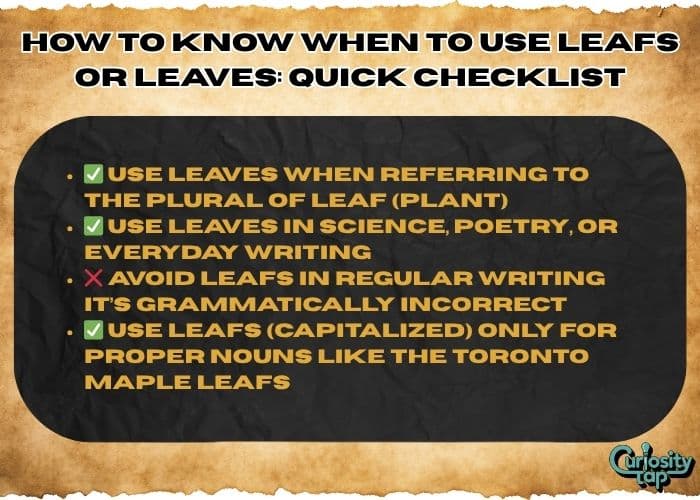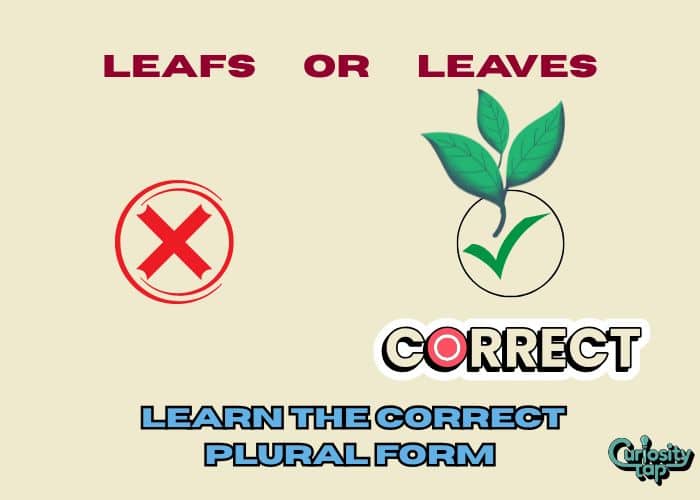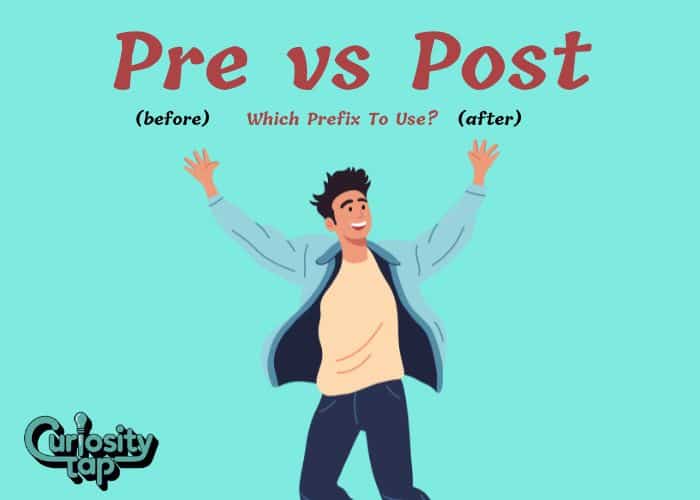Have you ever hesitated while typing the plural of “leaf”? You’re not alone. The “Leafs or Leaves” dilemma stumps even native English speakers. And the twist? Sometimes “leafs” is actually correct but only in very specific contexts.
In this guide, we’ll explore the grammar behind this confusion, the rules of plural formation, where each word is used, and the big exception that proves the rule. Let’s dive into the forest of English grammar and emerge fluent in the foliage of words.
Why Do We Say “Leaves” and Not “Leafs”?
The English language is full of irregular plural forms. Much like “child” becomes “children” and “man” becomes “men,” “leaf” becomes “leaves.”
The Grammar Rule Behind It
Most nouns that end in -f or -fe change the -f to -v and add -es in their plural forms:
- Wolf → Wolves
- Knife → Knives
- Wife → Wives
- Leaf → Leaves
Why the Change?
This transformation dates back to Old and Middle English, where the f → v shift happened for easier pronunciation. This isn’t a universal rule, though as you’ll see shortly, some exceptions do exist.
When “Leafs” Is Actually Correct
Surprise! There is one major exception to the rule: proper nouns.
Toronto Maple Leafs – The Famous Exception
If you’re a hockey fan, you’ve heard of the Toronto Maple Leafs, not Toronto Maple Leaves. Why?
Because “Maple Leafs” is a proper noun, governed by branding and style choices not grammar rules.
Real-Life Example:
In 1927, the Toronto NHL team changed their name from the “St. Patricks” to the “Maple Leafs,” inspired by the Canadian WWI regiment “Maple Leaf Regiment.” The team owner intentionally chose “Leafs,” preserving the word as a symbolic singular unit, not a literal plant.
This naming stuck, becoming a grammatically incorrect but contextually valid term.
Common Irregular Plural Nouns Like “Leaf → Leaves”
Here are other nouns that follow the same pattern:
| Singular | Plural |
|---|---|
| Leaf | Leaves |
| Calf | Calves |
| Half | Halves |
| Thief | Thieves |
| Shelf | Shelves |
🧠 Grammar tip: If a word ends in -f or -fe, check a dictionary. About 80% follow the f→v rule, but not all.
Real-Life Usage: Grammar in Action
Scenario:
Amara, an ESL student, was writing a fall-themed poem:
“The wind blew the colorful leafs from the trees…”
Her teacher gently corrected her:
“In English, the plural of ‘leaf’ is leaves.”
Amara asked, “But I’ve seen ‘Maple Leafs’ on TV?”
The teacher smiled, “That’s hockey. Proper nouns like team names break grammar rules for style or tradition.”
This moment helped Amara distinguish between formal grammar and cultural exceptions a lesson she now shares with other learners.
Also Read: Is It Scrapped or Scraped? Let’s Clarify the Confusion

How to Know When to Use Leafs or Leaves: Quick Checklist
Use this cheat sheet anytime you’re unsure:
✅ Use leaves when referring to the plural of leaf (plant)
✅ Use leaves in science, poetry, or everyday writing
❌ Avoid leafs in regular writing it’s grammatically incorrect
✅ Use Leafs (capitalized) only for proper nouns like the Toronto Maple Leafs
FAQs: People Also Ask
Is “leafs” ever grammatically correct?
Yes, but only as a proper noun like in the team name Toronto Maple Leafs.
What is the plural of leaf in science or botany?
It is always leaves in scientific and botanical contexts.
Why do some words ending in -f change to -ves?
This pronunciation shift helps with fluidity in speech. It’s a historical evolution in English.
Are there any rules for when to use -ves vs -fs?
There’s no hard rule. Some nouns like “roof” just become “roofs,” not “rooves.” Use a dictionary or memorize the most common ones.
Can “leafs” be a verb?
Yes. “To leaf through a book” can be conjugated as “he leafs through the pages,” but this is unrelated to the plural noun form.
Pros & Cons of Both Forms
| Form | Pros | Cons |
|---|---|---|
| Leaves | ✅ Grammatically correct in 99% of use | None |
| Leafs | ✅ Accepted in names/branding | ❌ Not standard in grammar |
| ✅ Used as a verb (he leafs through…) | ❌ Confuses ESL learners |
Conclusion: Stick with “Leaves” (Unless You’re Playing Hockey)
The correct plural of “leaf” is “leaves” almost always. Use “leafs” only in proper nouns like team names or when conjugating verbs like “leafing through.”
Understanding the difference doesn’t just improve your grammar it boosts your credibility as a writer, speaker, or language learner.
So next time you spot the golden leaves of fall, you’ll know you’re not just enjoying nature you’re mastering English too. 🍁
Sources
Sources:
- Merriam-Webster. (2024). Plural of leaf. https://www.merriam-webster.com/dictionary/leaf
- Grammarly. (2024). Leafs vs. Leaves: What’s the Difference? https://www.grammarly.com/blog/leafs-vs-leaves
- Oxford Learner’s Dictionaries. (2024). Leaf definition and plural. https://www.oxfordlearnersdictionaries.com/definition/english/leaf
Read more knowledgeable blogs on Curiosity Tap
Is this article helpful?

Jackson Pearson is a passionate educator and language enthusiast behind the blog Jackson Pearson. With years of experience in teaching and writing, he specializes in simplifying complex grammar rules, breaking down tricky vocabulary, and crafting learning guides that are both engaging and practical. His mission is to help readers boost their English skills whether they’re beginners or brushing up for fluency. Through every article, Jackson brings clarity, structure, and a spark of curiosity to the world of English learning.



